BEST GARDEN EVER, DROUGHT NOTWITHSTANDING
/4 Comments/in Gardening, Soil, Vegetables/by Lee ReichGo Drip!
This summer has been one of the hottest and driest ever — and it’s been one of the best ever in the vegetable garden. Baskets of red, ripe tomatoes and peppers sit on the kitchen floor awaiting metamorphosis into sauces and salsas, dehydration, or just plain being eaten.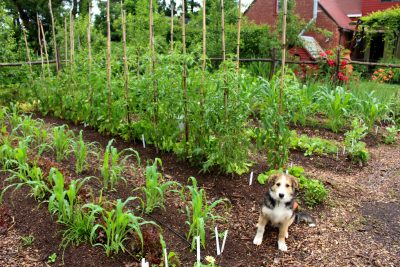
What about water? My garden plants are plump with water thanks to drip irrigation. In addition to benefits to the plant, drip is also good for the environment, typically using only about 40 percent of the amount of water used by sprinkling. That’s because the more pinpointed water avoids wasting water in paths and other places it’s not needed. Also because little water is lost to evaporation.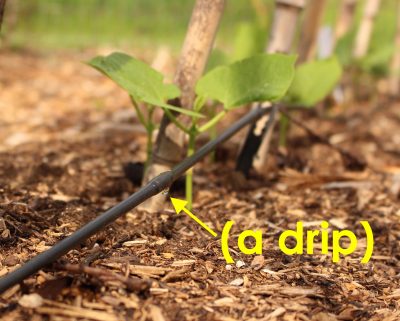
The “drip” in drip irrigation tells you that water is applied at a very slow rate, which is especially appealing to those of us whose water comes from a well. With drip, the well has plenty of time to recharge between waterings.
Drip is also better for plants. Leaves stay dry, lessening the chance for disease. And rather than flooding the ground, which a sprinkler does at each watering, drip keep soil moisture within that happy window when larger pores remain filled with air, and water is held within smaller pores so that roots can both breathe and draw in water. (This is one reason for the more efficient water use of drip irrigation.)
COMPOST TEA REVEALED
/3 Comments/in Pests, Soil/by Lee ReichFirst Step, Identification
A few years ago I went to a nearby permaculture convergence. (Actually a “permaculture conference; those people have the best terms for what they do). I’ve grown plants in what I learned was a permie way for many decades, so I’ve been accused of being a permaculturalist. I was even invited to do a presentation and host a farmden tour for the convergence.
While there, I had the opportunity to attend a lecture by someone who has been billed as the diva of dirt, or, at least, of compost tea, specifically aerated compost tea (ACT), Dr. Elaine Ingham. You’ve never heard of ACT!? It became the hot, new thing years ago, perhaps still is, as an alleged cure for poor soil and plant pests. I’d been skeptical and thought that hearing and speaking to Dr. Ingham in person could entice me into the fold.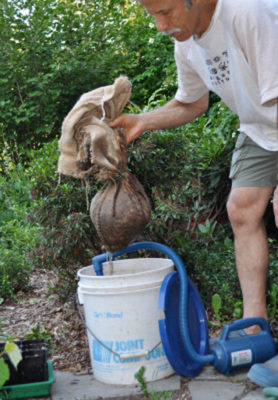
Dr. Ingham showed myriad images of fungi, nematodes, and other creatures that you might find in compost piles and teas. We saw many “bad guys” that lurk in poorly aerated composts and teas. The “bad guys” are bad, she asserted, because they release toxins into the soil and puff away valuable nitrogen, sulfur, and phosphorus in various forms as gases.
Dr. Ingham suggested monitoring our compost piles and tea happenings by purchasing a microscope and, with the help of her workshops, identifying resident microorganisms. Hmmm; interesting, but is it really necessary for a green thumb?
While the panoply of microorganisms discussed was impressive, I contend that even a well-aerated compost pile or tea is bound to have some poorly aerated pockets. It’s not a “bad guys” vs. “good guys” situation, but a question of generally favoring an excess of “good guys.” Also, once compost is spread on the ground, the large surface area presented is going to tip the balance even more in favor of aerobic conditions.
To identify what organisms are in a compost pile, you have to get them out of the pile and onto a microscope slide. Easy. Just soak some compost in water and strain it. Or use a compost teabag. But wait! Is that really the spectrum of microorganisms that call that compost home? Not necessarily. What are staring up at you from that microscope slide are creatures that can be leached most readily into water. What you see also might depend on how long you steeped the teabag and who can squeeze out into the water through whatever size holes are offered by the strainer or the teabag.
Will Compost Microbes be Happy Far from their Compost Home? More fundamentally, I question basic assumptions underlying the use of compost tea. Even if you have beneficial organisms in hand (figuratively) and sprinkle them on the ground, they’re bound to expire unless the environment is suitable. Microorganisms in the tea might have enjoyed life within the dark, moist innards of a compost pile; the soil environment ain’t nothin’ like home for them.
Spraying ACT or any compost tea on plant leaves should likewise have little or no effect on plant diseases; again, conditions on a leaf surface aren’t conducive to their survival. In the evolutionary scheme of things, why would a microorganism that thrives in the dark, moist, nutrient-rich innards of a compost pile survive on the sunny, dry, nutrient-poor surface of a plant leaf, let alone provide any benefits?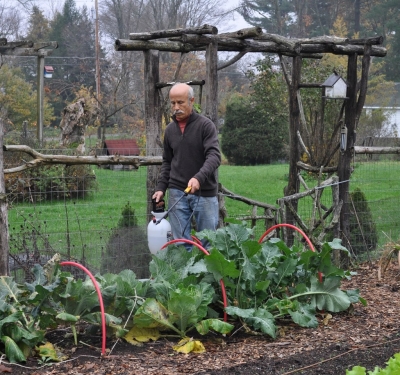
Over the last few decades, people have spritzed plants and sprinkled soils with compost tea, looking for effects such as improved soil structure or drainage or increased plant resistance to pests. Independent well-designed, vetted studies do not generally support claims made for compost tea.
True, there are some studies that show some benefits. I contend that if you spray just about anything on a plant leaf and have enough plants in the study along with sufficiently detailed measurements, some statistically significant effect might be noted. But every statistically significant effect isn’t also biologically significant. And looking over a number of studies, some few show a benefit from compost tea, many demonstrate no effect, and for a number of them, the effect of compost tea is detrimental.
Soluble nutrients do leach out of a compost teabag into water. The resulting compost tea, then, becomes a liquid feed for plants, effective either poured on the ground or even sprayed on leaves. So there can be some benefit from compost tea, a nutrient effect, not a microbial one.
Bulk is Good
Except in special situations, soil environments naturally host microorganisms that thrive best in them. A similar situation exists with earthworms. Years ago, perhaps still, advertisements in the back pages of gardening magazines would offer earthworms for sale. The reasoning went that good soils are teeming with earthworms, so purchasing and importing these creatures to you garden will make your soil better. Not true. The earthworms will die out if conditions and food are not to their liking. The same goes for microorganisms.
(An example of an exception to what I wrote in the previous paragraph is a study that was done in Puerto Rico back in 1950. THE USDA was trying, with little success to introduce a more useful, but non-native pine, to the island territory. Mycorrhizae are fungal symbionts that infect practically all plants; the fungus gets some foods manufactured by the plant in return for moving more nutrients and water to the plant for improved growth. The appropriate fungal symbiont was lacking in Puerto Rican soils. After inoculating plants with an appropriate fungus, the inoculated, introduced pines grew six times more than their introduced brethren that had not been inoculated.)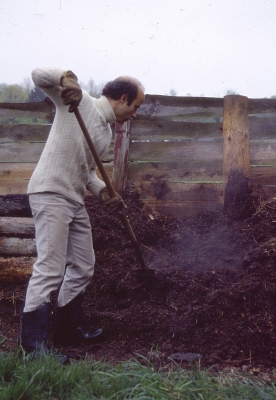
Except in rare situations, as in the example above, earthworms, microorganisms, and other creatures generally inhabit environments most congenial to their flourishing. Perhaps not enough of them, and what they really need is food to give their populations a boost, and food means some form of organic material. That is, bulky organic materials, such as compost, manure, leaves, and straw.
Good gardening comes form using a pitchfork, not an elixir. Does anybody still make and use compost tea?
WAITING FOR FIGS
/14 Comments/in Fruit/by Lee Reich(Much of the below information is gleaned from my book Growing Figs in Cold Climates and a video I presented, now available online.)
Affliction
If you’re not growing figs because you think your cold winter climate is wrong for them, you’re wrong and you’re missing out on an exotic treat. Figs can be grown just about everywhere. If you are growing figs and you’re in a cold winter climate, the fruits should be nearly or already ripening.
Impatience is the affliction of the cold climate fig grower. I’m feeling it right now, as I write. That impatience comes from watching little figlets forming and expanding early in the season and then just sitting on the branches, doing nothing, seemingly forever. Knowing something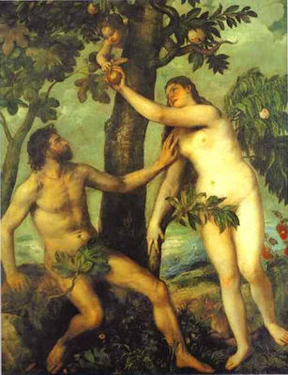 of how fig fruits develop and grow, and ways that ripening can be hastened along helps soothe my affliction.
of how fig fruits develop and grow, and ways that ripening can be hastened along helps soothe my affliction.
Let Me Know Thy Ways (of Fruiting)
Most varieties of figs bear fruit on new, growing shoots. This bearing habit is very different from that of most common fruits, such as apples, peaches, and blueberries, which bear fruit on stems that are one-year-old or older. (Some fig varieties do bear on one-year-old stems, and some bear on both one-year-old and new, growing shoots.) Figs’ bearing habit is a boon to cold climate fig growers because that means that a fig tree can still bear fruit even if its stems freeze back or are pruned back rather severely.
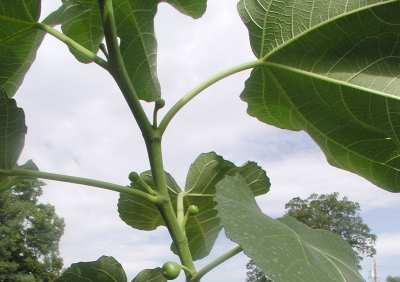
Figs forming on new shoot
But it takes time for fruits on young fig stems to develop and ripen, which they do sequentially from the bottom (the oldest) part of the growing stem to the top. The closer a stem originates to the roots, the longer it takes for fruit on that stem to develop and ripen. That time could be too long, depending on how severely the plant was pruned or froze back and the length of the growing season. I like to develop and leave one or more permanent trunks at least two feet long, letting sprouts grow from or at their tops.
Some so-called “hardy” figs sprout new shoots from ground level after dying back from winter cold. Actually, since ground temperatures in winter are milder than air temperatures, many figs will do this. Problem is that figs will form on those sprouts from ground level but may not have time to ripen.
Quicken the Pace
Assuming a portion of trunk or trunks have survived winter, perhaps because the plant was potted and moved to shelter, the trunk was insulated, or the trunk was buried, etc., impatience still lurks. (I detail a number of ways to get figs through winter in my book Growing Figs in Cold Climates.) The problem — for us, not the figs — is that fruit growth follows a sigmoidal (S-shaped) curve over time. That is, the fruits swell up rapidly early in the season, then just sit for a long time.
But hang tight. If all else is in order, fruit growth leaves the flat part of the curve, and figs start to rapidly swell, at the same time softening and developing a rich, sweet flavor. How long before ripening begins depends on the where the fruiting shoot originated, the variety, and the growing season.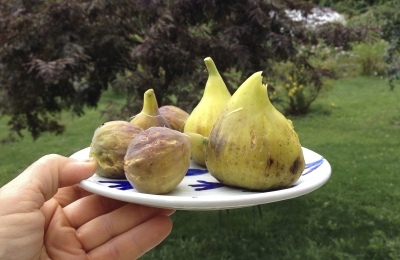
Fortunately, you can hasten along ripening to some degree. The first way is earlier in the season, when a shoot has just a few leaves, say about five. If you pinch out the growing tip, that could stimulate figs down along the stem to start developing sooner than if the stem was left alone. However, doing so also might reduce total yield because shoot growth is at least temporarily stalled.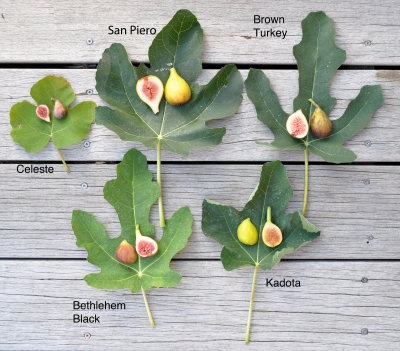
As fruits near ripening, they can be hurried along by “oiling.” Do this by putting a drop of olive oil in the eye of a fruit; I just dip a chopstick in the oil and then let the oil drip off onto the eye.  Very important: Don’t try this on a fruit very far from ripening, which is, of course, hard to tell until the fruit starts ripening. But if you really love your fig tree, you’ve been staring at it a lot. As you do so you’ll begin to notice subtle changes. I’ve typically used this method towards the end of the growing season when fig ripening slows with waning sunlight and cooling temperatures.
Very important: Don’t try this on a fruit very far from ripening, which is, of course, hard to tell until the fruit starts ripening. But if you really love your fig tree, you’ve been staring at it a lot. As you do so you’ll begin to notice subtle changes. I’ve typically used this method towards the end of the growing season when fig ripening slows with waning sunlight and cooling temperatures.
Wait!
Whatever you do, don’t harvest any figs before they are fully ripe. Figs, like many other fruits do not ripen at all once they have been harvested. Incipient rot might make harvested, underripe fruits a bit sweeter, but that’s different from ripe. Commercial figs are harvested just short of full ripeness because then they can be shipped without damage.
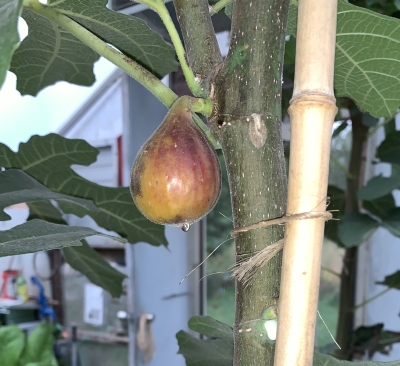
When your fig is fully ripe, the fruit is soft and perhaps has a “tear” in its eye. The flavor will be sweet and rich.

